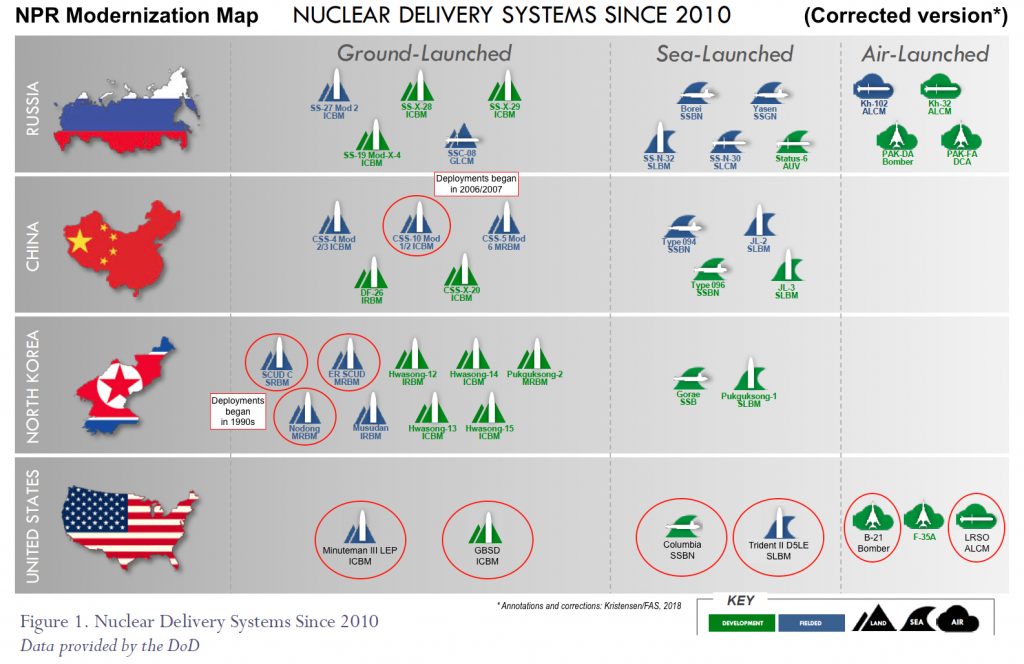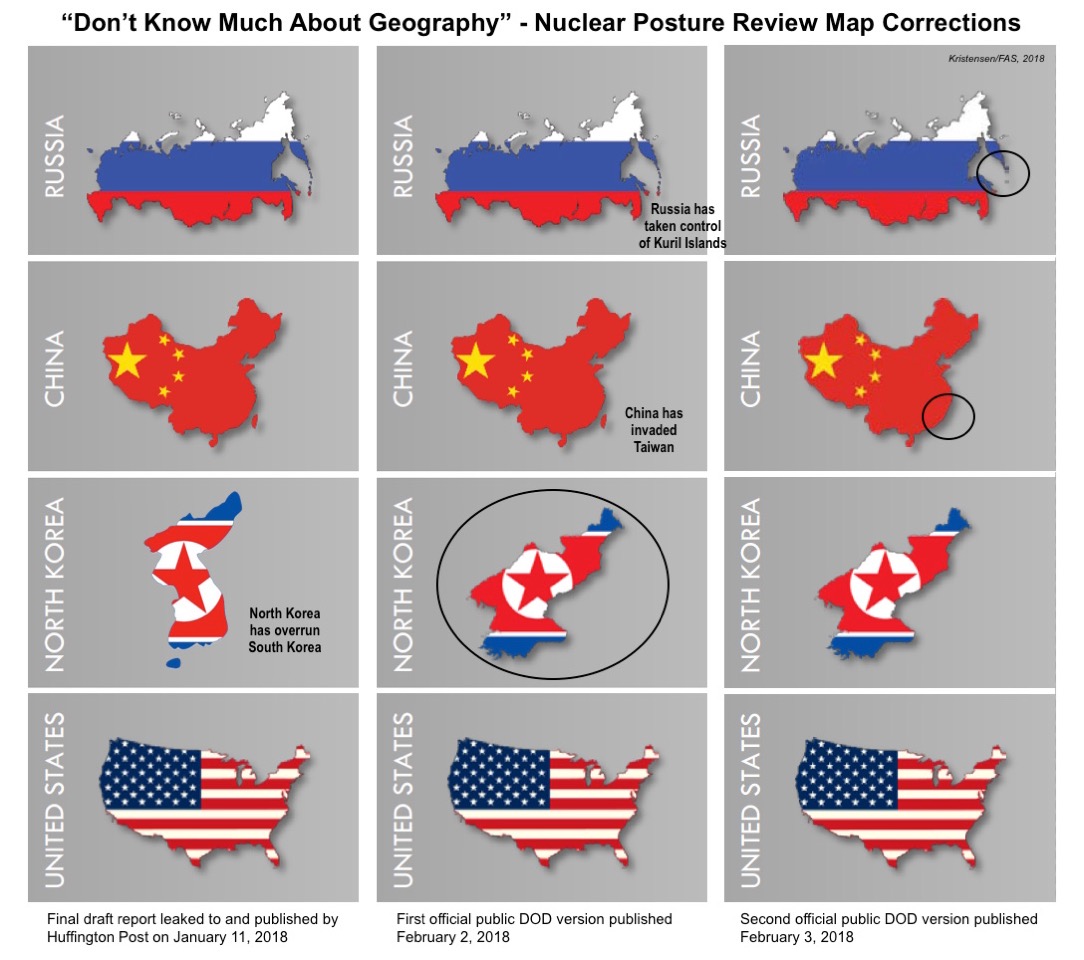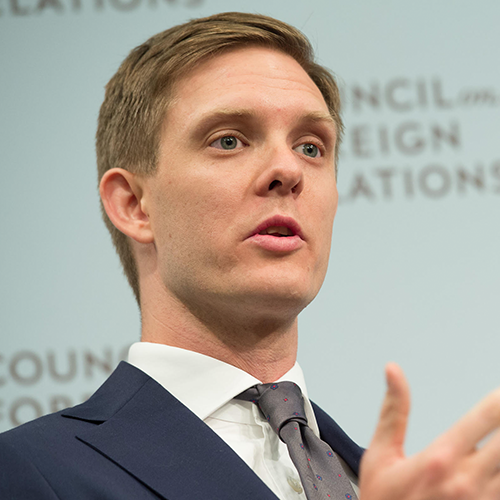2018 Nuclear Posture Review
Updated: 2/6/2018, 15:32
The Nuclear Posture Review (NPR) is the Pentagon’s primary statement of nuclear policy, produced by the last three presidents in their first years in office.
The Trump NPR perceives a rapidly deteriorating threat environment in which potential nuclear-armed adversaries are increasing their reliance on nuclear weapons and follows suit. The review reverses decades of bipartisan policy and orders what would be the first new nuclear weapons since the end of the Cold War. Furthermore, the document expands the use of circumstances in which the United States would consider employing nuclear weapons to include “non-nuclear strategic attacks.”
You can view the first version of the document here.
You can also view the leaked draft document here.
EXPERTS COMMENT ON TRUMP NUCLEAR POSTURE REVIEW LEAK, OFFICIAL RELEASE
The 2018 NPR says US nuclear forces “contribute uniquely to the deterrence of both nuclear and non-nuclear aggression” (208). Conventional forces, it states, “do not provide comparable deterrence effects,” and “do not adequately assure many allies,” (851), many of whom rely on US conventional deployments for their security. In addition, the document states they contribute to assuring allies, achieving US objectives if deterrence fails, and hedging “against an uncertain future” (981). The review also raises the possibility of a nuclear strike against any group that “supports or enables terrorist efforts to obtain or employ nuclear devices,” extending previous language (2051).
The review also creates a new category of cases in which the United States would consider use of nuclear weapons—“significant non-nuclear strategic attacks,” to include attacks on “civilian population or infrastructure” (917, 1026). This new category helps serve as justification for “supplements to the planned nuclear force replacement program” (1751).
- George Perkovich (CEIP), “Really? We’re Gonna Nuke Russia for a Cyberattack?,” Politico, 1/2018
- Amy F. Woolf, “Strategic Nuclear Forces: Background, Developments, and Issues,” Congressional Research Service, 8/2017
- Anna Péczeli, “Best Options for the Nuclear Posture Review,” Strategic Studies Quarterly, Fall 2017
- Robert Einhorn and Steven Pifer, “Meeting U.S. Deterrence Requirements: Toward a Sustainable National Consensus,” Brookings Institution working group report, 9/2017
- Keith B. Payne and John S. Foster, Jr, “A New Nuclear Review for a New Age,” National Institute for Public Policy, 4/2017
Overall, the NPR argues that a range of Russian and Chinese activities have caused the international threat environment to worsen (636), but it does not fully explain why these activities require increased reliance on nuclear weapons. It states that other nuclear-armed adversaries have failed to follow America’s lead in reducing reliance on nuclear weapons (678). In this, it claims that Russia plans for “limited nuclear first use” to prevail in limited conflict (694), though there is thin evidence that this is Russian doctrine. The document concedes that China has not altered its doctrine, while North Korea’s capabilities are so rudimentary that “increased reliance” has little meaning.
- James N. Miller, Jr. and Richard Fontaine, “A New Era in U.S.-Russian Strategic Stability,” Center for a New American Security, 9/2017
- Mark B. Schneider, “Escalate to De-escalate,” US Naval Institute Proceedings, 2/2017
- Kristin Ven Bruusgaard, “Russian Strategic Deterrence,” Bulletin of the Atomic Scientists, July 19, 2016
- Olga Oliker, “Russia’s Nuclear Doctrine,” Center for Strategic and International Studies, 5/2016
- Hans M. Kristensen, “DOD: Strategic Stability Not Threatened Even By Greater Russian Nuclear Forces,” FAS Strategic Security Blog, October 10, 2012
- Hans M. Kristensen, “Non-Strategic Nuclear Weapons,” FAS Special Report No. 3, May 2012
- Hans M. Kristensen, “Russian Nuclear Forces: Buildup or Modernization,” Russia Matters, September 14, 2017
- Hans M. Kristensen and Robert S. Norris, “Russian nuclear forces, 2017,” Bulletin of the Atomic Scientists, March 2017
The United States is engaged in a 30 year effort to refurbish or replace nearly every warhead and delivery vehicle in air, sea, and land legs of the nuclear triad. The modernization program (formally known as the Program of Record) was initiated by the Obama administration and the Trump NPR has pledged to continue this effort. Despite calls from some external sources, the 2018 review makes no reductions in Obama’s modernization plan. Instead, the NPR calls for new nuclear SLCM and a low-yield SLBM warhead. The NPR also seems to call for retention of the 1.2 megaton B83 nuclear bomb (which had been slated for retirement once the B61-12 enters service) with contradictory statements for when the warhead may be retired (462 & 1900 vs. 325 & 1529) and what the replacement might be.
- Hans M. Kristensen, “CBO Study Presents Options For A More Affordable Modernization Plan,” FAS Strategic Security Blog, October 31, 2017
- Todd Harrison and Evan Linck, “Options for the Ground-Based Leg of the Nuclear Triad,” Center for Strategic and International Studies, 9/2017
- Adam Mount and Lawrence Korb, “Setting Priorities for Nuclear Modernization,” Center for American Progress, 2/2016
The NPR promises to “in the longer term, pursue a modern nuclear-armed sea-launched cruise missile (SLCM) which “will provide a needed non-strategic regional presence, an assured response capability, and an INF-Treaty compliant response to Russia’s continuing Treaty violation” (395, 1729). The document also hopes that the program will help convince Russia to “negotiate seriously a reduction of its non-strategic nuclear weapons,” and return to compliance with the INF Treaty. Critical experts believe that a new SLCM would inhibit US forces from carrying out their conventional missions, add little new capability, and would be more likely to cause Russian reprisal than compliance.
- Sandy Winnefeld, USN(ret) & James N Miller, “Bring Back the Nuclear Tomahawks,” USNI, 5/2017
- Luke O’Brien, “The TLAM-N: A Counterproductive Anachronism for Europe,” RCD, 6/2017
- Hans M. Kristensen, “US Navy Instruction Confirms Retirement of Nuclear Tomahawk Cruise Missile,” FAS Strategic Security Blog, March 18, 2013
- Hans M. Kristensen, “Japan Rejects TLAM/N Claim,” FAS Strategic Security Blog, January 24, 2010
- Hans M. Kristensen, “Japan’s Nuclear Secret,” SEKAI, October 2009
- Hans M. Kristensen, “Japan, TLAM/N, and Extended Deterrence,” FAS Strategic Security Blog, July 2, 2009
The NPR calls for modifying “a small number of existing SLBM warheads to provide a low-yield option” (1715) that “will help counter any mistaken perception of an exploitable ‘gap’ in U.S. regional deterrence capabilities” (1724). It is a policy directly contrary to the Obama NPR’s affirmation that warhead development “will not support new military missions or provide for new military capabilities;” there currently are no low-yield SLBM warheads in the arsenal. The Trump NPR argues that this new capability would provide the option to rapidly strike a target with a lower nuclear yield than current options, hoping to communicate limited intentions or limit collateral damage. The new capability would blur the distinction between strategic and non-strategic weapons by what appears to be a sub-strategic SLBM mission. Launch of a low-yield SLBM would expose the submarine and its other warheads to retaliation and there is no guarantee that an adversary would understand the strike was limited, whether while in the air or once detonated.
- Vince Manzo, “Give the Low -Yield SLBM its Day in Court,” Defense One, 1/2018
- Hans M. Kristensen, “The Flawed Push For New Nuclear Weapons Capabilities,” FAS Strategic Security Blog, June 29, 2017
The NPR document calls the nuclear mission “an affordable priority,” (1647) noting that “even the highest” of cost projections is “approximately 6.4 percent of the current DoD budget” (1660). Yet, Obama administration officials, military leaders, and federal research agencies have all warned that there is currently no plan to pay what CBO had estimated as the $1.2 trillion cost of operating the arsenal over the next thirty years. If Congress appropriates additional funds to meet the NPR’s requirements (and if there are cost overruns in the acquisition programs), this figure will increase.
- Congressional Budget Office, “Approaches for Managing the Costs of U.S. Nuclear Forces, 2017 to 2046,” 10/2017
- Government Accountability Office, “NNSA: Action Needed to Address Affordability of Nuclear Modernization Programs,” 4/2017
- Kingston Reif, “The Trillion (and a Half) Dollar Triad?,” Arms Control Today, 8/2017
Overall, the NPR seems to deemphasize and downplay the prospects for strategic arms control. The document says that the United States “remains willing to engage in a prudent arms control agenda,” (556) adds a new qualification for arms control agreements—that they be “verifiable and enforceable” (514, 540). This standard may prohibit agreements like President George H. W. Bush’s 1991 Presidential Nuclear Initiatives, which were largely voluntary. Furthermore, it is not clear whether any international agreement can be “enforceable.” Additionally, the document also states that the government “does not support ratification” of the Comprehensive Test Ban Treaty, which could allow the government to pursue activities incommensurate with the spirit of the treaty.
- Alexei Arbatov, “An Unnoticed Crisis: The End of History for Nuclear Arms Control?,” Carnegie Endowment for International Peace,” 6/2015
- Kingston Reif and Victor Mizin, “A Two-Pronged Approach to Revitalizing U.S.-Russia Arms Control,” Deep Cuts Commission, 6/2017
- Kingston Reif and Tom Countryman, “How congressional Republicans are trying to undermine U.S.-Russia relations,” Washington Post, 8/2017
- Adam Mount, “Anticipatory Arms Control,” Deep Cuts Commission, 6/2016
Status of World Nuclear Forces (with R. Norris)
FAS Nuclear Notebook series (with R. Norris), Bulletin of the Atomic Scientists
New Data Shows Detail About Final Phase of US New START Treaty Reductions FAS Strategic Security Blog, 1/2018
NNSA’s New Nuclear Stockpile Stewardship and Management Plan FAS Strategic Security Blog, 11/2017
The Flawed Push For New Nuclear Weapons Capabilities FAS Strategic Security Blog, 6/2017
Trump’s Troubling Nuclear Plan Foreign Affairs, 2/2018
Letting It Be An Arms Race The Atlantic, 1/2018
The Case Against New Nuclear Weapons, Center for American Progress, 5/2017
Adapting Nuclear Modernization to the New Administration, Bulletin of the Atomic Scientists, 2017
Setting Priorities for Nuclear Modernization (with L. Korb), Center for American Progress, 2/2016
Fact Checks

NPR chart earns three Pinocchios for misleading public: “A Pentagon chart misleadingly suggests the U.S. is falling behind in a nuclear arms race,” Washington Post, 2/12/2018

Geography graphics across the three versions of the Nuclear Posture Review (draft, official version, and updated version) with corrections and clarifications. (Hans Kristensen/FAS)
Other Expert Analysis
Anna Péczeli, “Continuity and change in the Trump administration’s Nuclear Posture Review,” Bulletin of the Atomic Scientists, 2/20/2018
John R. Harvey, et al., “Continuity and Change in U.S. Nuclear Policy,” Real Clear Defense, 2/7/2018
Steven Pifer, “Questions about the Nuclear Posture Review, Brookings, 2/5/2018
Matthew Harries, “A nervous Nuclear Posture Review,” IISS, 2/5/2018
Rebecca Hersman, “Nuclear Posture Review: The More Things Change, The More They Stay the Same,” Defense Outlook 2018 (CSIS), 2/2018
James Acton (CEIP), “Command and Control in the Nuclear Posture Review: Right Problem, Wrong Solution,” War on the Rocks, 2/5/2018
Andy Weber, “Trump Call for New Nukes Will Make America Less Safe,” The Cipher Brief, 2/4/2018
The Washington Post editorial, “Trump’s request for even more nuclear weapons is flawed overkill,” 2/3/2018
Alicia Sanders-Zakre (Arms Control Association), “Why we should reject Trump’s dangerous nuclear plan,” Bulletin of the Atomic Scientists, 2/2/2018
Tom Z. Collina (Ploughshares), “Give Trump more nuclear weapons and more ways to use them? Not a good idea,” CNN, 2/2/2018
Rachel Bronson, Sharon Squassoni, Hans M. Kristensen, and Alicia Sanders-Zakre, “The experts on the Nuclear Posture Review,” Bulletin of the Atomic Scientists, 2/2/2018
Anne Armstrong and Cassandra Varanka, “Taking on Trump’s Dangerous Nuclear Posture Review,” Ms. Magazine blog, 2/2/2018
Jon Wolfsthal (Global Zero), “US Approach to Russia in New Nuclear Posture Review Risks Boosting Chances of Conflict,” Russia Matters, 2/2/2018
Joe Cirincione (Ploughshares), “Nuclear Nuts: Trump’s New Policy Hypes The Threat and Brings Us Closer to War,” Defense One, 2/2/2018
Michaela Dodge (Heritage), “5 Myths About the Nuclear Posture Review,” Daily Signal, 2/2/2018
Mark Perry, “Trump’s Nuke Plan Raising Alarm Among Military Brass,” The American Conservative, 2/2/2018
William J. Hennigan, “Donald Trump Is Playing a Dangerous Game of Nuclear Poker,” Time Magazine, 1/1/2018
Paul Bracken (Yale), “The 2018 Nuclear Posture Review: Signaling Restraint with Stipulations,” FPRI, 2/1/2018
16 US Senators, Letter to the President on the NPR, 1/29, 2018
Rep. Adam Smith, “Smith Statement on the Nuclear Posture Review,” House Armed Services Committee Democrats, 1/24/2018
Lisbeth Gronlund and Stephen Young, “The U.S.’s Dangerous New Nuclear Policy,” Aviation Week, 1/26/2018
Michaela Dodge (Heritage), “Trump’s Nuclear Posture Review Must Keep us Safe,” National Review, 1/22/2018
Andy C. Weber (Harvard), “Trump Wants New Nukes. We Can’t Let Him Have Them,” Huffington Post, 1/19/2018
Michèle Flournoy, Interview with WNYC, 1/18/2018
Michael Krepon (Stimson), “The Most Dangerous Word in the Draft Nuclear Posture Review,” Defense One, 1/23/2018
Fred Kaplan, “Nuclear Posturing: Trump’s official nuclear policy isn’t that different from his predecessors.‘ That’s what makes it so scary,” Slate, 1/22/2018
Vince Manzo (CNA), “Give the Low -Yield SLBM its Day in Court,” Defense One, 1/22/2018
Joan Rohlfing, Jon Wolfsthal, Thomas Countryman, Arms Control Association briefing, Press Briefing with Experts on the Trump Nuclear Posture Review, 1/23/2018
George Perkovich (CEIP), “Really? We’re Gonna Nuke Russia for a Cyberattack?,” Politico, 1/2018
Loren Thompson (Lexington), “Trump’s Nuclear Strategy Is Basically The Same As Obama’s,” Forbes, 1/2018
Jon Wolfsthal and Richard Burt (Global Zero), “America and Russia May Find Themselves in a Nuclear Arms Race Once Again,” The National Interest, 1/2018
Tom Z Collina (Ploughshares Fund), “Give Trump new nukes and we are that much closer to war,” The Hill, 1/2018
The New York Times Editorial Board, “False Alarm Adds to Real Alarm About Trump’s Nuclear Risk,” 1/13/2018
Daryl G. Kimball, (Arms Control Association), “Trump’s More Dangerous Nuclear Posture,” Arms Control Today, 1/2018
Jon Wolfsthal (Global Zero), “Say No To New, Smaller Nuclear Weapons,” War on the Rocks, 11/2017
Brad Roberts (LLNL), “Strategic Stability Under Obama and Trump,” Survival, 7/2017
Jon Wolfsthal (Global Zero), “How Will Trump Change Nuclear Weapons Policy?” Arms Control Today, 11/2017
Robert Einhorn and Steven Pifer (Brookings), “Meeting U.S. Deterrence Requirements,” Brookings, 9/2017
The third Nuclear Posture Review set out from the start to produce an comprehensive public document. In this way, the review served several purposes: it provided an opportunity to interpret President Obama’s Prague commitment to seek the peace and security of a world without nuclear weapons, to explain the strategic benefits of the New START treaty and to establish the force structure to comply with it, and served as a prominent and public way of communicating with allies and adversaries. The central compact was that as long as nuclear weapons exist, the United States will maintain a safe, secure, and effective deterrent. In this way, the NPR could endorse modernization and sustainment investments while reducing the role and number of nuclear weapons. Though relatively modest in terms of force structure changes, the document’s main innovation was to declare that the United States will not use or threaten to use nuclear weapons against nonnuclear weapons states that are party to and remain in compliance with their obligations under the Nonproliferation Treaty.
- Nuclear Posture Review Report, April 2010
- Report on Nuclear Employment Strategy of the United States, June 2013
- Hans M. Kristensen, “The Nuclear Posture Review,” FAS Strategic Security Blog, April 8, 2010
- Hans M. Kristensen, “Nuclear Posture Review to Reduce Regional Role of Nuclear Weapons,” FAS Strategic Security Blog, February 22, 2010
- Hans M. Kristensen, “New Nuclear Weapons Employment Guidance Puts Obama’s Fingerprint on Nuclear Weapons Policy and Strategy,” FAS Strategic Security Blog, June 20, 2013
- Hans M. Kristensen, “US Nuclear War Plan Updated Amidst Policy Review,” FAS Strategic Security, April 4, 2013
The second NPR was marked by inventive concepts and poor public relations. The intention was to produce a classified document that would be briefed publicly. In open testimony, Undersecretary of Defense for Policy Doug Feith described the NPR as an attempt rethink deterrence for a world where Russia was no longer an enemy. The nation’s strategic posture would no longer depend on Mutual Assured Destruction, but one Feith said would have “the flexibility to tailor military capabilities to a wide spectrum of contingencies.” Operational concepts would rely more on prompt conventional strike and defensive capabilities. To enhance flexibility, the NPR seemed to endorse development of new earth-penetrating warheads and also required a responsive infrastructure that could quickly produce and test new capabilities if a threat arose. Moving away from MAD allowed for a reduction of deployed warheads below 2,200, but the NPR mandated no further modifications to force structure. Three months after the initial briefing, selections of the classified report leaked to the media and were widely criticized by arms control groups and foreign officials. Fairly or unfairly, many read the leaked sections as blurring the line between nuclear and conventional weapons and refusing to accept mutual vulnerability. Administration officials scrambled to clarify but never fully dispelled concerns, leaving more questions than answers.
- “Excerpts of Classified Nuclear Posture Review,” 1/2002
- Amy F. Woolf, “The Nuclear Posture Review,” Congressional Research Service, 1/2002
- Douglas J. Feith, Testimony before Senate Armed Services Committee on the Nuclear Posture Review, 2/2002
- Keith B. Payne, “The Nuclear Posture Review: Setting the Record Straight,” United States Nuclear Strategy Forum, 2005
- Hans M. Kristensen, “STRATCOM Cancels Controversial Preemption Strike Plan,” FAS Strategic Security, July 25, 2008
- Hans M. Kristensen, “The RISOP is Dead – Long Live RISOP-Like Nuclear Planning,” FAS Strategic Security Blog, July 21, 2008
- Hans M. Kristensen, Robert S. Norris, and Ivan Oelrich, From Counterforce to Minimal Deterrence, FAS Occasional Paper No. 7, April 2009
- Hans M. Kristensen, “White House Guidance Led to New Nuclear Strike Plans Against Proliferators, Document Shows,” FAS Strategic Security Blog, November 5, 2007
- Hans M. Kristensen, “The Role of U.S. Nuclear Weapons: New Doctrine Falls Short of Bush Pledge,” Arms Control Today, 9/2005
President Clinton ordered the first NPR to examine the role of nuclear weapons after the end of the Cold War. A five-person steering group led six working groups. The established process broke down in the summer of 1994 over tensions the steering group and the military stakeholders. In the end, the review failed to generate a unitary document; its results were briefed to the press and to Congress. The 1994 NPR established a force structure to comply with the START II Treaty and ordered cuts to each leg of the triad: conversion of four Ohio-class submarines and all B-1 bombers to conventional missions, reduction in B-52 and Minuteman III inventories, and elimination of Minuteman II and Peacekeeper ICBMs. Secretary of Defense Bill Perry summarized the NPR as an attempt to provide leadership for further reductions while hedging against the emergence of threats.
- Office of Assistant Secretary of Defense (Public Affairs), “DOD Review Recommends Reduction in Nuclear Force,” 9/1994
- US Strategic Command, “Overview of Nuclear Posture Review (NPR) Results,” 9/1994
- John Deutch and Adm. William Owens, Senate Armed Services Committee “Briefing on the Results of the Nuclear Posture Review,” 9/1994<
- Hans M. Kristensen, “The 1994 Nuclear Posture Review,” nukestrat.com, July 8, 2005
Satellite imagery of RAF Lakenheath reveals new construction of a security perimeter around ten protective aircraft shelters in the designated nuclear area, the latest measure in a series of upgrades as the base prepares for the ability to store U.S. nuclear weapons.
It will take consistent leadership and action to navigate the complex dangers in the region and to avoid what many analysts considered to be an increasingly possible outcome, a nuclear conflict in East Asia.
How the United States responds to China’s nuclear buildup will shape the global nuclear balance for the rest of the century.
The bootcamp brought more than two dozen next-generation open-source practitioners from across the United States to Washington DC, where they participated in interactive modules, group discussions, and hands-on sleuthing.

